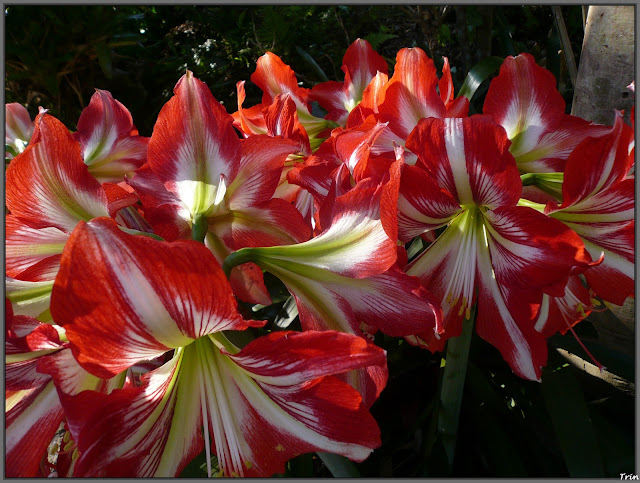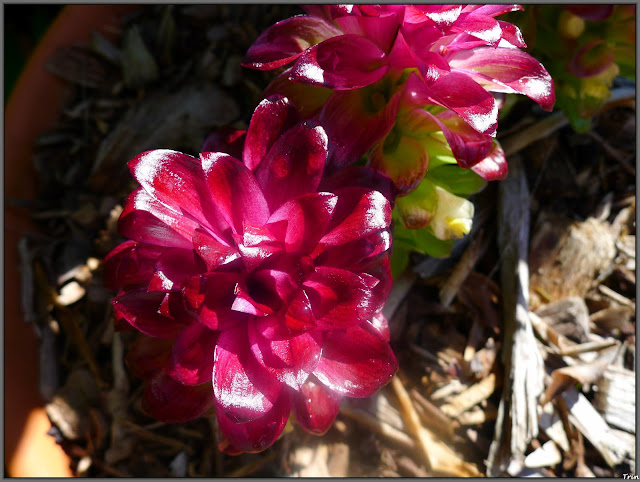Daylily; Hemerocallis, very popular flowering plant in my garden. I have always been fascinated with these
easily to grow and very reliable perennials.They have made huge leaps in looks with gorgeous colours, frills, different sizes from giants to dainty minis. They start flowering in October and keep going for 3-4 month, depending on the plant.
Quisqualis indica also known as Rangoon Creeper. a vine with red flower clusters. It is found in Asia and in many other parts of the world. The genus translates into Latin for What is that?
For more information http://en.wikipedia.org/wiki/Quisqualis_indica
Callistemon viminalis, a red weeping bottlebrush; Do you spot the green Lorikeet enjoying the nectar of the flowers.
Dark red Hybrid Tea. Mister Lincoln
Bred by Swim & Weeks (United States, 1964).
Tall. Matte, dark green, leathery foliage.
Height of 3' to 6' 7" (90 to 200 cm). Width of 2' (60 cm).
Hardy. vigorous. heat tolerant. In warmer climates, cut back the remaining canes by about one-third.
This rose does very well in my subtropical garden especially when it is dry.
“We can complain because rose bushes have thorns, or rejoice because thorn bushes have roses.”
Abraham Lincoln
A variegated, French bred rose; floriferous and not affected by diseases.
Hippeastrums, prominently red from October into December
I like this dwarf, red Canna lily, flowering from spring to late summer.
Hippies lighten the borders from October into December.
Curcuma is a genus of about 80 accepted species in the plant family Zingiberaceae that contains such species as turmeric and Siam Tulip. The name comes from Arabic kurkum meaning "turmeric". Since assembly of the genus Curcuma by Linnaeus in 1753 about 130 species have been described so far. Some of the species descriptions are without Latin diagnosis or type specimen, therefore the legitimate status of many species is suspicious and remains unclear.
Carl Linnaeus stating that all organisms bear relationships on all sides, their forms changing gradually from one species to the next. From Philosophia Botanica (1751).
Believe it or not:
This world, after all our science and sciences,
is still a miracle;wonderful, inscrutable, magical














Beautiful, beautiful reds!They add so much life and vibrancy to a garden. I loved that stream of Hippeastrums (though I loved your label of 'hippies' even more!)
ReplyDeleteSunita, thank you for visiting my garden.
ReplyDeleteLiebe Trudi, du zeigst ein wahres Feuerwerk an herrlichen Farben aus deinem Garten. Eine Wohltat für die Augen, die hier seit Tagen nur weiss, d.h. Schnee überall, sehen. Aber du hast ja jetzt eine ganz andere Jahreszeit (die ich eigentlich dem Winter vorziehe!). Den Satz von T. Carlyle finde ich wunderbar (habe ihn mir gleich notiert). Ich werde nun wieder vermehrt in Blogland "mitmischen", bin wieder etwas motiviert :-) !!
ReplyDeleteSei lieb gegrüsst und einen schönen Advent wünsche ich dir!
Barbara
Hi Titania, I am still catching up with some of my favourite blogs. Sorry I haven't dropped by for a while. Red is my favourite colour, so I love everything you have shared, especially the lovely deep red of the curcuma.
ReplyDeleteMarisa, glad to see you around, I have been slack, summer does that to me!
DeleteLiebe Barbara; danke dir herzlich für deinen so liebenswerten Kommentar. Alles Gute und schöne Weihnachten mit deiner Familie. Hugs T.
ReplyDelete